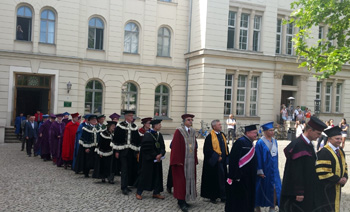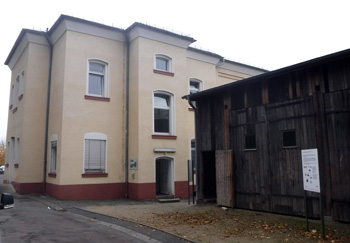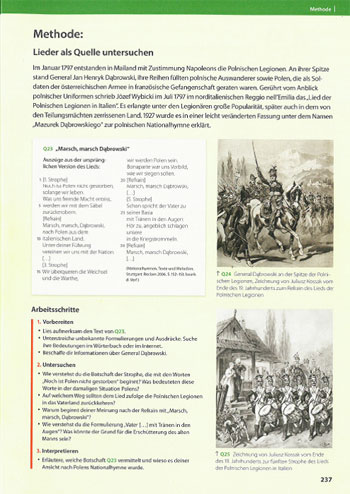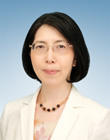Looking Back at My Stay and Research in Germany
Atsuko Kawakita
Professor, Faculty of Letters, Chuo University
Areas of Specialization: Contemporary German History, German Studies
My research period in Germany

Wittenberg University, which was founded in the 16th century, integrated with the Halle University in the aftermath of Napoleon's Invasion. The photo shows a parade of representatives from inside and outside the university at an event celebrating the 200th anniversary of the integration, which was held during my stay in the university.
The Japan Society for the Promotion of Science established the Fund for the Promotion of Joint International Research (Fostering Joint International Research) in 2015, primarily aimed at young researchers. I applied for the fund in the initial year and was fortunate enough to be selected to get a chance to conduct research at the Martin Luther University of Halle-Wittenberg (MLU) in Germany for one year.
Halle (Saale) City, in which MLU is located, is a medium-sized city in the area that was formerly East Germany. Ever since the refugee crisis in Europe in 2015, the number of refugees seeking residence in cities in Germany has sharply increased, and I could still feel its aftermath when I travelled to Germany in the spring of 2017. The German public opinion concerning the acceptance of refugees was divided, and xenophobic views were especially prevalent in the eastern part of Germany, but the atmosphere in Halle was comparatively stable, probably due to Halle being a university town (however in the autumn of 2019, after I had returned to Japan, a shooting incident occurred in a synagogue in Halle City, which shocked me greatly).
Writing a monograph
I was assigned an office in the MLU Institute for History, where Professor Manfred Hettling who accepted me worked, and I spent the first 3 months summarizing my past research, spending most of my time in my office and the university library.
I have continued my research on the expulsion of Germans in the immediate aftermath of World War II. Expulsion here refers to the forced migration of German population from Eastern Europe, including the vast region of East Germany which was ceded to the Soviet Union and Poland after Germany's defeat in World War II. Under the severe circumstances of arbitrary killings, pillaging and sexual violence that had spread far and wide, some 15 million people migrated to Germany. This was over two times the number of Japanese citizens living in Japan's overseas and occupied territories who were repatriated back to Japan during the same period after its defeat in the Pacific War, and is regarded as one of the largest ethnic migrations in world history.
I had written about the expulsion of Germans in my doctoral thesis, but had not compiled my work into a book, so during my stay in Germany, I altered the structure of my doctoral thesis to make it suitable for publication. I made drastic revisions after receiving advice from the historians of MLU. I greatly expanded the range of discourse and delineated the events from the beginning of the migration of German speaking people to Eastern Germany in the German Eastward Expansion during the Middle Ages, the period of World War I when efforts were made to divide land among different ethnic groups through the population transfers following a rise in nationalism and belief in the self-determination of people, to the migration policies for various "races" under Nazi Germany and the resulting genocide of Jewish people, all the way to the reconstruction of regional order after World War II resulting in the unfolding of various population transfers all over Europe (one of which was the expulsion of Germans). In my doctoral thesis, I had only discussed the integration of the people who underwent forced migration into post-war Germany, but by taking into account the long-term developments, the global historical context of this event became clearer to me. The book was published under the title of The "Expulsion" of the German Population from Eastern Europe: Rethinking the History of Population Transfers in the Twentieth Century (Hakusuisha Publishing - 2019) and I was grateful to have it covered in the book reviews of various media like Shukan Dokushojin and Tosho Shimbun, as well as in book review sessions in the Society for the Study of Modern History and the Historical Science Society of Japan.
Perspective for new research
While conducting my research on the topic of the expulsion, I was always curious about the fact that Japan and Germany, two countries with very similar experiences after World War II, were mostly unaware of each other's experiences. For that reason, I wondered if I could research the similarities in the population transfers in Europe and Asia after World War II, and decided to begin my research after finding a thesis contributed to Diplomatic History by Lori Watt, an American scholar specializing in Japan, right before my voyage to Germany.

Hadamar is one of the locations where euthanasia was practiced in Nazi Germany. The memorial hall (further back) still houses a basement that was used to execute people. In front of the hall is a garage for buses which carried the victims to the hall. Photo taken when visiting the University of Giessen.
This was a thesis looking into the vision of the Allied Nations concerning the repatriation of Japanese people living in overseas and occupied territories back to Japan after its defeat in the Pacific War, and mentioned how the Special Committee on Migration and Resettlement under the United States Department of State formulated a plan for the population transfers in Europe before examining the repatriation of Japanese people. Because the Notter File (Post-World War II Foreign Policy Planning. State Department Records of Harley A. Notter, 1939-1945) that Watt relied on was stored at the university library in the University of Göttingen in Germany, I headed to Göttingen after finishing the revision of my doctoral thesis and put together a thesis based on an empirical investigation into how the Allied Nations' post-war plans regarding the expulsion of German population in Europe and the repatriation of Japanese people after Japan's defeat in the Pacific War were connected. This thesis is included in Repatriation, Expulsion, Residue - Comparative Research into Post-War International Migration (The University of Nagoya Press, 2019) which I edited together with Professor Shinzo Araragi and Professor Yusuke Matsuura.
Further, as an extension of the idea of connecting the experiences in Europe and Asia, I started planning research on the global scale of migration starting from the final years of World War II to the consolidation of the Cold War. The research, in addition to the Japan-Germany case, would examine the changing logic of migration accompanying the changes in international circumstances that could be observed in the regions at the frontlines of the Cold War by the mid-1950s, like Poland, Czechoslovakia, Hungary, and the Balkan Peninsula in Europe as well as the Korean Peninsula and Vietnam in Asia. During the second half of my stay in Germany, I presented and discussed my research plan at the colloquia in MLU and the University of Giessen.
Valuable learning for my teaching
Gathering documents and archival materials, presenting my research paper and interactions related to my research were the main purposes of my stay in Germany this time, but I also had many interesting experiences in terms of my teaching. I had always wanted to know the type of lessons being given to undergraduate students in universities in Germany, and I was grateful to get the opportunity to observe the lessons given to students in their initial year in the MLU Institute for History multiple times (lectures and practical exercises). Since it was decided that I would be starting a lecture on contemporary German history after returning to Japan, I had started preparing lecture materials during my stay in Germany, and the content of the lectures and the teaching methods I observed in these courses proved to be extremely useful when considering how to achieve the two separate objectives of concretely describing specific historical periods and historical events, and teaching the basics of the methodology of historical sciences (the types of historical materials, critique of historical sources, the relation between historical facts and interpretation of history, etc.).

A page regarding the reading and understanding of historical sources from a history textbook in Germany. The page contains one written source (poem) and two related visual sources. By answering the questions asked at the lower left side of the page in order, one can learn how to read and understand of historical sources and is encouraged to think about the historical background of the event depicted.
Further, when teaching students how to write their graduation thesis, the goal is to write a thesis using primary historical sources, but this is definitely not an easy task. In order to use primary sources of German history that are written in German in one's graduation thesis, it is important for students not only to learn methodology of historical sciences, but also to acquire language skills to understand academic terms in German language within a four-year undergraduate course. Regarding this point, I investigated some German textbooks on history at the Georg Eckert Institute for International Textbook Research in Braunschweig and used the pages addressing the methodology of historical sciences (specifically pages regarding the ways to critically analyze historical sources) in order to look for a way to learn the methodology of historical sciences and the German language simultaneously, and presented my results at the JaF-DaF Forum 2018, held in Hamburg (joint presentation with my colleague, Professor Akiko Hayashi). In Japan, there is an active discussion on how to gain the ability to think historically based on historical records, in preparation for the introduction of Comprehensive History as a new subject in high school. In future, I intend to provide information on how methodology of historical sciences is taught at high schools and the first year of university in Germany, to be utilized in foreign language education and historical education fields.
During my stay in Germany, I gathered valuable insights and experiences both as a researcher as well as a professor. I want to express my heartfelt gratitude to the many professors in the MLU Institute for History, my colleagues in the Faculty of Letters of Chuo University and the Japan Society for the Promotion of Science for giving me this valuable opportunity.
-
Professor, Faculty of Letters, Chuo University
Areas of Specialization: Contemporary German History, German Studies In 1997, she graduated from the College of Arts and Sciences, the University of Tokyo.
In 1999, she completed the Master’s Program in the Graduate School of Arts and Sciences in the University of Tokyo.
In 2002, she completed the Doctoral Program in the Graduate School of Arts and Sciences in the University of Tokyo.
She has obtained a PhD. (University of Tokyo)
She served as Project Associate Professor at the Center for German and European Studies in the Graduate School of Arts and Sciences, College of Arts and Sciences, the University of Tokyo, Komaba. Associate Professor at the Graduate School of Language and Culture, Osaka University, and Associate Professor in the Faculty of Letters, Chuo University before assuming her current position in 2015. Presently, she is researching population transfers in twentieth century Europe, war reparations and the compensation of war victims in Germany after World War II, memory of war and violence, etc.
Her main written works include The ‘Expulsion’ of the German Population from Eastern Europe. Rethinking the History of Population Transfers in the Twentieth Century (Hakusuisha Publishing – 2019), History Teaching in Germany (Hakusuisha Publishing – 2005), Ian Kershaw’s Hitler (#1) 1889 – 1936: Hubris (Hakusuisha Publishing, 2015; in charge of translation), and more.








